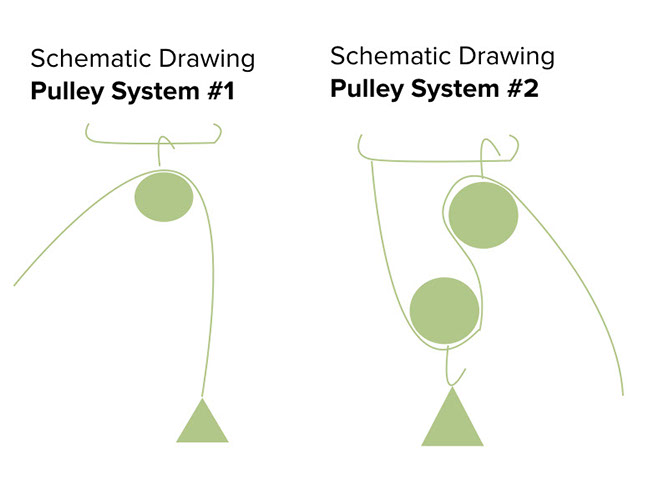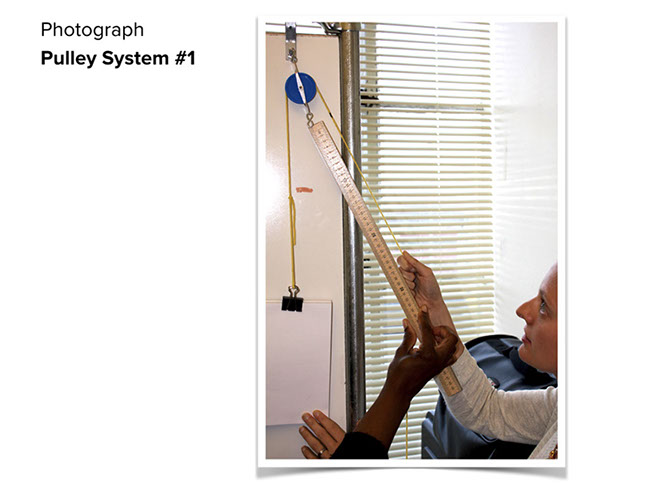SciGen Teacher Dashboard
Unit E2
Work and Machines
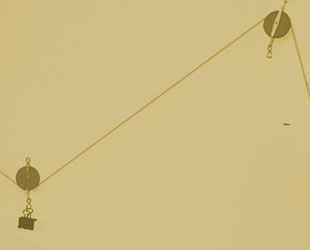 Lab: The Helpful Pulley
Lab: The Helpful Pulley
Duration: Approximately 60 minutes
Students explore how pulleys work by building them, then they collect and analyze data on force and distance needed to move a load in a pulley system.
LEARNING OBJECTIVE
Students collect and analyze data on force and distance needed to move a load in a pulley system.
Teacher Tips
-
If you don't have pulleys, here are some ideas to collect or make them:
- Use the hubs of large wheels from construction sets like Lego and K'Nex.
- Spools (like those for thread or the larger spools, as those inside of rolls of ribbon)
- Hot-glue a sandwich of two large caps and one smaller cap together. (To find the center of this wheel, trace the larger cap onto paper, cut it out, and fold in half, then rotate and fold in half again. The intersection of the two folds marks the center.) If you don't have enough caps, you can hot-glue a cap between two pieces of paperboard or cardboard. You just need to make a groove that will prevent the string from slipping off the wheel.
Materials (per group):
- 2 pulleys
- string (6 feet or 2 meters)
- a load to lift (such as a binder clip)
Teacher Tune-ups
Teaching Notes
ACTIVITY OVERVIEW
- About Grandpa's textbook (10 minutes)
- Set Up the pulley lab (15 minutes)
- Compare load movement to string pull (20 minutes)
- Summarize findings (15 minutes)
About Grandpa's textbook (10 minutes)
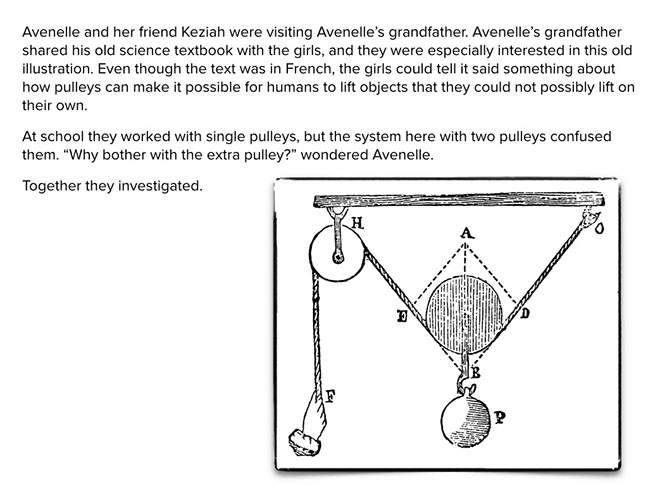
Discuss the images from Avenelle's grandfather's text book.
From the student worksheet:
Avenelle and her friend Keziah were visiting Avenelle’s grandfather. Avenelle’s grandfather shared his old science textbook with the girls, and they were especially interested in this old illustration. Even though the text was in French, the girls could tell it said something about how pulleys can make it possible for humans to lift objects that they could not possibly lift on their own.
At school they worked with single pulleys, but the system here with two pulleys confused them. “Why bother with the extra pulley?” wondered Avenelle.
Together they investigated.
Setting up the pulley lab (15 minutes)
Students now embark on a second investigation by creating two pulley systems. On this page they are asked to consider how much force they must apply to lift the load off the table or floor.
Materials required include 2 pulleys, string, and a load to lift.
The two images show possible materials and how to attach the pulleys on a stiff piece of cardboard or wood. The load in the image is a binder clip with papers attached. The load can be anything that you can clip on or tie a string around. A coffee mug weighs enough and has a handle to tie. If you don’t have stiff cardboard or wood to hang the pulleys, you can use lab stands. Equally effective is to put a chair on top of a table and hang the pulley from a bar or slat. For the second system, the two pulleys should be at least 30 centimeters apart.
Read the instructions together and then be sure that students understand that the first task is to feel how much force they need to apply in order to lift the load in each of the 2 systems. You may ask them to predict before they construct the systems which will require the greater force.
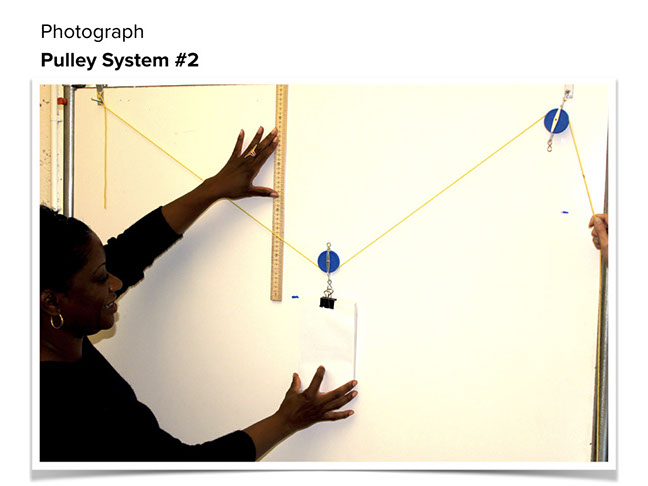
Compare load movement and string pull (20 minutes)
Read the instructions and emphasize that students should pull the string exactly 30 centimeters. Challenge them to find a way to accurately measure how far they have pulled the string. If students have difficulty devising a method, ask them to describe where on the string they will measure when they begin. Can they mark the string? Also, ask whether it is ok if the string is loose before they begin pulling.
Once the string has been pulled 30 centimeters, a lab partner must measure how high the load has traveled.

Summarize findings (15 minutes)
Challenge students to write at least two complete sentences to answer the prompt on the bottom of the page. Students should observe that pulley system #1 required more force than #2, and that the load moved 30 centimeters. System #2 required less force than #1 and the load moved about 15 centimeters. Of course, not all measurements will be accurate, but in the summary students should state that with two pulleys less force was required but the load was lifted about half as far as the string was pulled.
Our group pulled both strings 30 centimeters. We found that for system #1, more force was needed. More force times 30 centimeters will equal a greater amount of work. For system #2, less force was needed to raise the load. Less force times 30 cm means that the work for system #2 is less than #1 and the load won’t go up as far. For system #1, the load moved up 30 centimeters. For #2 the load went up only 15 cm so for system #2, the work must be less than the work exerted for system #1.
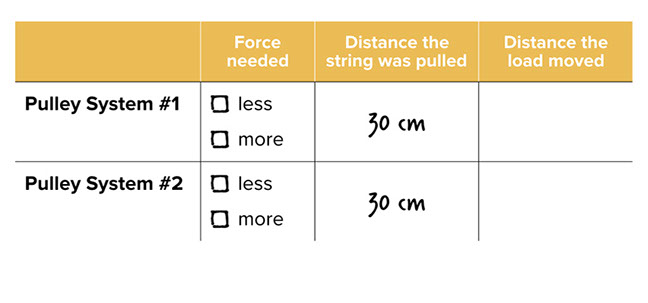
BETA Version - Please send comments and corrections to info@serpinstitute.org
